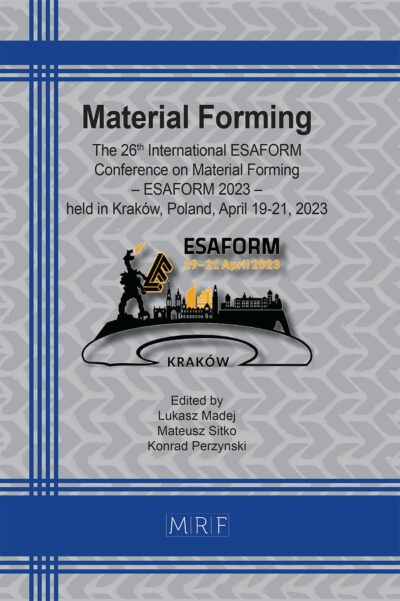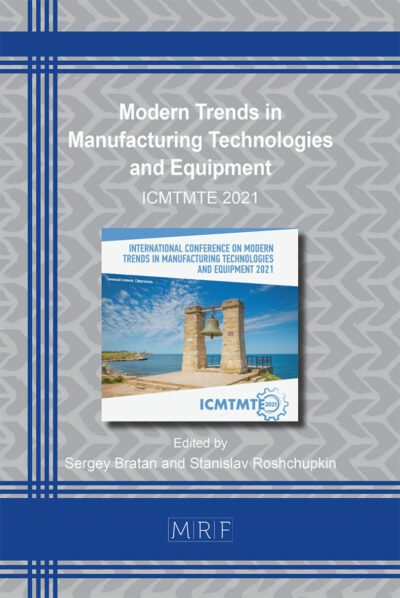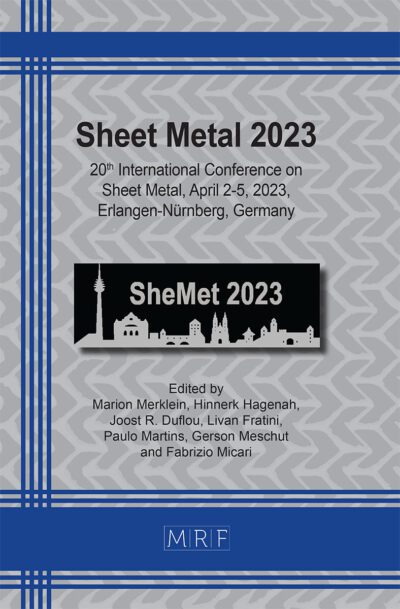Investigation of heat transfer dependencies in quenching of extrusion profiles based on experiment and FEM simulation
KNIAZKIN Ivan, KRYLOV Vladimir, SHITIKOV Andrei, KULAKOV Ivan, BIBA Nikolay
download PDFAbstract. The objective of this study is to establish a comprehensive method, devoid of computational fluid dynamics (CFD) calculations, for determining the surface heat transfer coefficient during spray cooling. This technique enables the derivation of the heat transfer coefficient’s dependence on the temperature of the cooled surface by utilizing known data regarding the number, relative positioning, and catalog characteristics of nozzles. Additionally, adjustable parameters of the quenching system such as the pressure and flow rates of water and air are considered in the methodology. Implemented within the commercial finite element (FE) package QForm UK, this technique is validated using independent experimental data that faithfully replicates real production conditions encountered during the quenching of extruded profiles made from aluminum alloys.
Keywords
Quenching, Aluminium, Qform, Extrusion, Heat Transfer, Spray Cooling, Cooling Rate
Published online 4/24/2024, 10 pages
Copyright © 2024 by the author(s)
Published under license by Materials Research Forum LLC., Millersville PA, USA
Citation: KNIAZKIN Ivan, KRYLOV Vladimir, SHITIKOV Andrei, KULAKOV Ivan, BIBA Nikolay, Investigation of heat transfer dependencies in quenching of extrusion profiles based on experiment and FEM simulation, Materials Research Proceedings, Vol. 41, pp 723-732, 2024
DOI: https://doi.org/10.21741/9781644903131-80
The article was published as article 80 of the book Material Forming
![]() Content from this work may be used under the terms of the Creative Commons Attribution 3.0 license. Any further distribution of this work must maintain attribution to the author(s) and the title of the work, journal citation and DOI.
Content from this work may be used under the terms of the Creative Commons Attribution 3.0 license. Any further distribution of this work must maintain attribution to the author(s) and the title of the work, journal citation and DOI.
References
[1] Bikass, S., B. Andersson, A. Pilipenko, and H. P. Langtangen. Simulation of the distortion mechanisms due to non-uniform cooling in the aluminum extrusion process. International journal of thermal sciences 52 (2012) 50-58. https://doi.org/10.1016/j.ijthermalsci.2011.06.002
[2] Negozio, M., Segatori, A., Pelaccia, R., Reggiani, B., & Donati, L. (2024). Experimental investigation and numerical prediction of the peripheral coarse grain (PCG) evolution during the extrusion of different AA6082 aluminum alloy profiles. Materials Characterization, 113723. https://doi.org/10.1016/j.matchar.2024.113723
[3] Tiryakioglu, M., and G. Totten. Quenching aluminum components in water: Problems and alternatives. In Heat Treating: Proceedings of the 18 th Conference, October 12 th-15 th. 1998.
[4] WILLIAMS William M., SANDNES Lise, MA Jun, TRONVOLL Sigmund Arntsønn, WELO Torgeir. Yield stress and work hardening behavior of extruded AA6082 profiles under different homogenisation and extrusion conditions. Materials Research Proceedings 28 (2023) 467-476. https://doi.org/10.21741/9781644902479-51
[5] Osten, Julia, Benjamin Milkereit, Michael Reich, Bin Yang, Armin Springer, Karina Nowak, and Olaf Kessler. Development of precipitation hardening parameters for high strength alloy AA 7068. Materials 13(4) (2020) 918. https://doi.org/10.3390/ma13040918
[6] Mei, R. B., L. Bao, C. S. Li, J. K. Wang, and X. H. Liu. FE analysis of 6063 aluminium profiles with complex cross-section during online quenching processes. Mechanics 21(2) (2015) 99 106. https://doi.org/10.5755/j01.mech.21.2.11733
[7] Kniazkin I., Kulakov I., Shitikov A., Raedt H.-W. Quenching of extruded profiles – finite element simulation as a tool to minimise profile distortion. Aluminium Extrusion Industry, April (2022) 34-35.
[8] Golovko, A. N., D. Rodman, F. Nürnberger, M. Schaper, Ya V. Frolov, and S. M. Beliaiev. Investigation of the Water-Air Cooling Process of the Thick-Walled Extruded Profile Made of Alloy En Aw-6060 on the Output Table. Metallurgical & Mining Industry 4(2) (2012).
[9] Information on https://www.spray.com/ /media/dam/industrial/usa/sales material/catalog/cat76a aa_metric.pdf
[10] Abramovich, G. N., Girshovich, T. A., Krasheninnikov, S. I., Sekundov, A. N., and I. P Smirnova. The theory of turbulent jets. Moscow Izdatel Nauka,1984.
[11] Schlichting, H., Gersten, K. Turbulent Free Shear Flows. In: Boundary-Layer Theory. Springer, Berlin, Heidelberg, 2017. https://doi.org/10.1007/978-3-662-52919-5_22
[12] Golovko, O., I. Frolov, D. Rodman, F. Nürnberger, O. Grydin, and M. Schaper. Spray cooling of extruded EN AW-6082 aluminium alloy sheets: spatial heat transfer coefficients. Forschung im Ingenieurwesen 3(78) (2014) 131-137. https://doi.org/10.1007/s10010-014-0181-y














